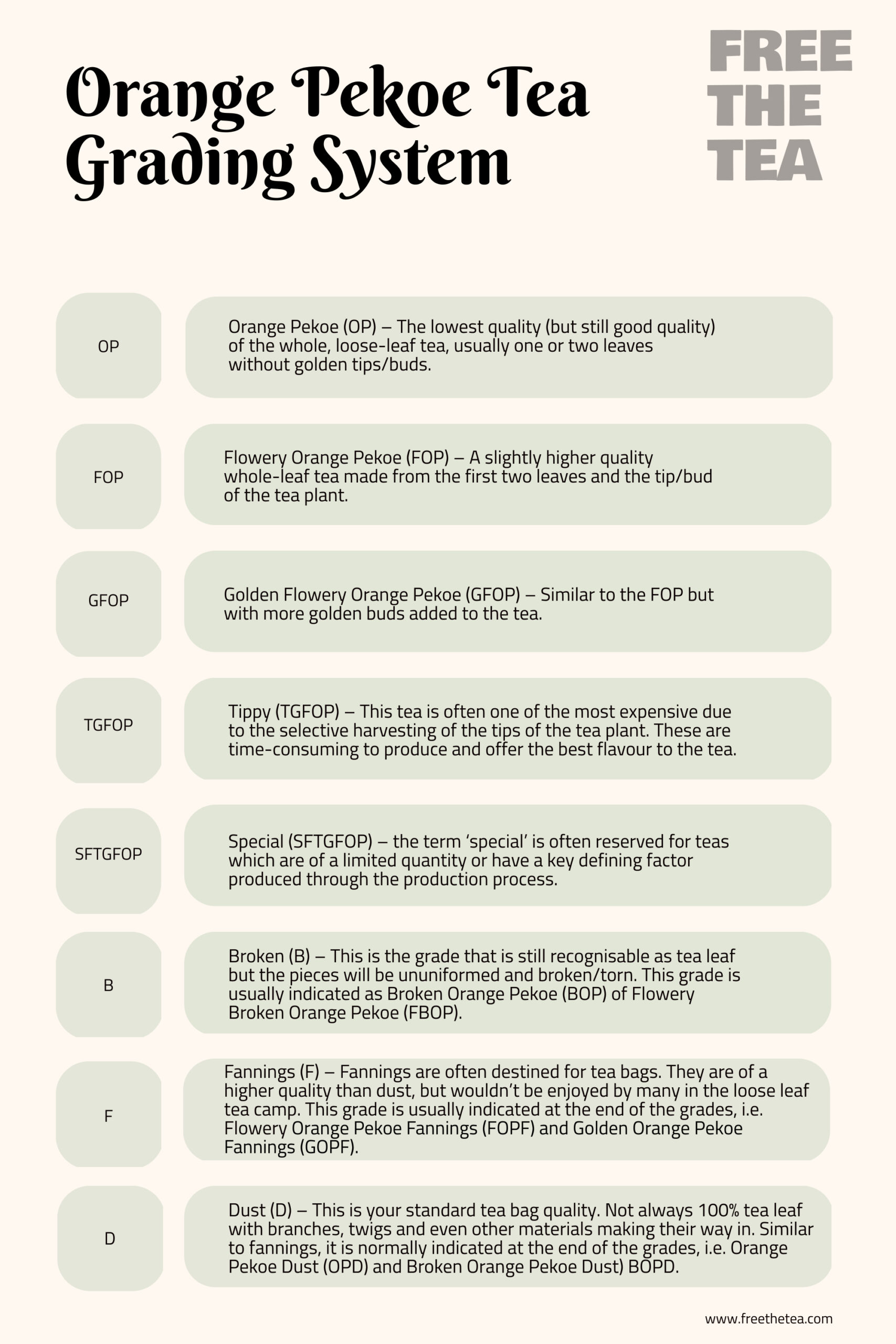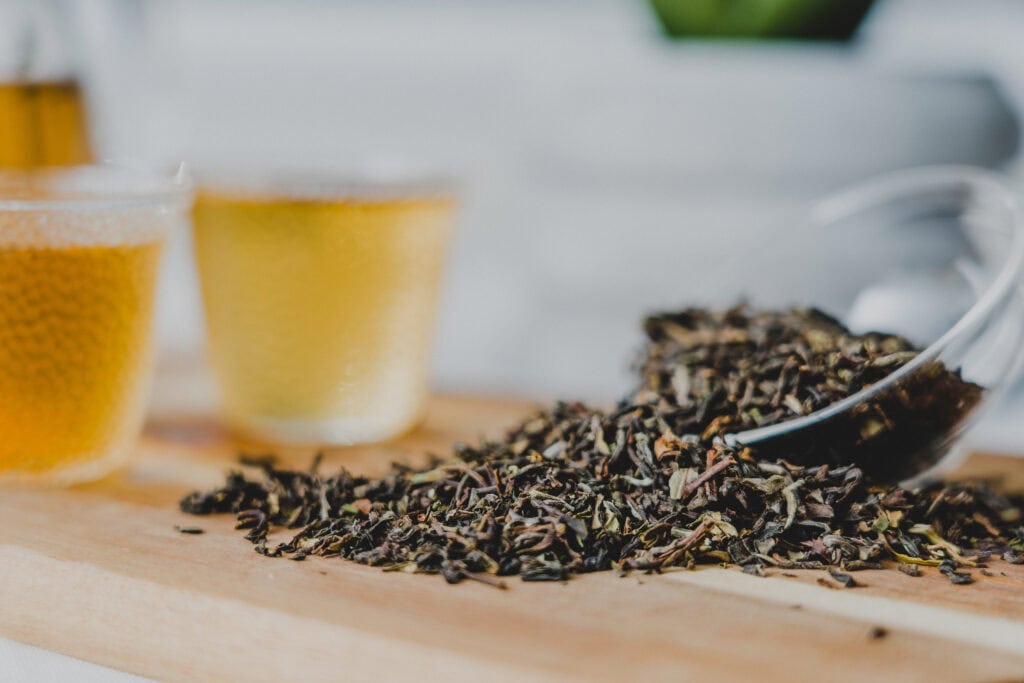In many parts of North America and Europe, the term Orange Pekoe (or OP) tea is often used incorrectly, usually as a marketing tactic.
In this post, I will look at what exactly Orange Pekoe is and help you understand all you need to know for when you next see “Orange Pekoe” written on a pack of tea.

What exactly is Orange Pekoe?
Orange Pekoe is part of a grading classification system of black tea as opposed to a type of tea. One Orange Pekoe can taste completely different to another as the name doesn’t relate to taste, but the size and quality of the tea leaf.
I have created an infographic below for your reference which I hope will make this a little easier to understand.

The Pekoe grading system is used predominantly in India, Sri Lanka (Ceylon) and some other areas of Asia. However, this is not the grading system for Chinese, Japanese, Taiwanese or African tea-growing countries. These countries and the regions within them, all have their own grading systems. But for this post, I’ll only be focusing on the Orange Pekoe system.
This type of tea leaf grading is actually very helpful if used correctly, and not as a marketing ploy. By being able to understand the quality of the tea leaf, you can make sure that you are getting the best quality tea.
The Orange Pekoe grade is given to the first flush (or picking) which is generally picked in Early Spring. These are the tea leaves that are the youngest on the plant and also pack the most flavour. This is why they are deemed a higher-quality tea. The highest quality tea leaves will include the buds of the plant. These contain the highest amount of nutrients and antioxidants.
Is all Orange Pekoe High-Quality Tea?
Traditionally, the grading of this higher-quality tea was saved only for the whole, loose-leaf tea leaves. This meant it was expensive and enjoyed only by those who could afford it. However, through years of marketing and dilution of the grades, Orange Pekoe can be used to describe even the lowest quality of blended tea dust or fannings.

If a tea merchant is transparent about their tea quality, they will normally use one of the below abbreviations to help the customer know exactly what quality they are buying.
Orange Pekoe Grading System
- Orange Pekoe (OP) – The lowest quality (but still good quality) of the whole, loose-leaf tea, usually one or two leaves (not the top one/two leaves) without golden tips/buds.
- Flowery Orange Pekoe (FOP) – A slightly higher quality whole-leaf tea made from the first two leaves and the tip/bud of the tea plant.
- Golden Flowery Orange Pekoe (GFOP) – Similar to the FOP but with more golden buds added to the tea.
- Tippy (TGFOP) – This tea is often one of the most expensive due to the selective harvesting of the tips of the tea plant. These are time-consuming to produce and offer some of the best teas.
- Special (SFTGFOP) – The term ‘special’ is often reserved for teas which are of a limited quantity or have a key defining factor produced through the production process.
- Broken (B) – This is the grade that is still recognisable as tea leaf but the pieces will be ununiformed and broken/torn. This grade is usually indicated as Broken Orange Pekoe (BOP) of Flowery Broken Orange Pekoe (FBOP).
- Fannings (F) – Fannings are often destined for tea bags. They are of a higher quality than dust, but wouldn’t be enjoyed by many in the loose-leaf tea camp. This grade is usually indicated at the end of the grades, i.e. Flowery Orange Pekoe Fannings (FOPF) and Golden Orange Pekoe Fannings (GOPF).
- Dust (D) – This is your standard tea bag quality. Not always 100% tea leaf, with branches, twigs and even other materials making their way in. Similar to fannings, it is normally indicated at the end of the grades, i.e. Orange Pekoe Dust (OPD) and Broken Orange Pekoe Dust (BOPD).
While that is a lot to digest, the main takeaway is that when you see ‘Orange Pekoe’ on a packet of tea bags, it is simply a tea which is from India, Sri Lanka or another country which uses the Orange Pekoe grading system.
I should say that tea bags are not bad. They are the main way the majority of Western tea drinkers enjoy their brew. But, if you have found yourself on this blog, you may be interested in exploring higher-quality tea options and there are plenty of them out there.

One tip I have is to look for tea brands which don’t just label the product as “Orange Pekoe” without any more information. Instead, look for the country of origin, the estate where the leaves were picked and even the season it was picked. These are all great ways to ensure you are getting your hands on some delightful blends without falling foul of over-priced, lower-quality teas.
How did Orange Pekoe get its name?
While there are a few different theories as to how the name Orange Pekoe came about, it is very likely that the true story comes from the Tea Trade Wars.
During the 1700’s the East India Tea Company (a vast and powerful trading arm of the British navy which had a right to fight in wars and take land on behalf of the British Crown) was imposing heavy taxes on all tea sold in the Colonies (present-day United States of America). This led to a lot of political upheaval and one notable event you may have heard of, ‘The Boston Tea Party’.
Before the history-changing events in Boston, the British-owned East India Company weren’t the only group with tea to be sold. Dutch tea traders in the 17th and 18th Centuries would often smuggle tea into the Colonies to undercut the tax-heavy British tea. They would deliver tea to areas like Boston, New York and Philadelphia, where East Coasters would buy up the tea at a fraction of the cost of the East India Company tea.
“What’s the connection to Orange Pekoe?”, I hear you ask!
This tea got its name from the Dutch Royal Family, known as ‘The House of Orange’, a name dating back to 1163. Due to the best quality tea originally being kept for royalty, the whole-leaf (unbroken) product was given the ‘orange’ in its name as a nod to the exceptional quality.

This is why ‘Orange Pekoe’ is not a term often used in the United Kingdom. The name itself is much more likely to be used in the coastal regions of East and North America/Canada today, where the tea trade played a significant role in the formation of these areas. Thankfully over time, tea became much more accessible and as a result, cheaper to buy.
The word Pekoe comes from the Chinese word ‘pek-ho’. This refers to the tiny white downy hairs which appear on the bud/tips of the pickings. These are a result of hand rolling during the rolling process of tea production. These little white ‘hairs’ are small fibres that are revealed because of the processing, and signal higher-quality tea.
Does Orange Pekoe have any orange flavour in it?
This is one of the biggest misconceptions with Orange Pekoe and for good reason. While it does have the word ‘orange’ in its name, Orange Pekoe doesn’t contain any orange flavour. It doesn’t even smell like oranges!
The word ‘Orange’ in the name simply refers to the history associated with the Dutch royal family.
Is there any caffeine in Orange Pekoe Tea?
Orange Pekoe is no different to any other black tea and will contain caffeine unless it has been processed to be decaffeinated. In a standard 10oz (295ml) cup of brewed Orange Pekoe tea, it will contain about 45-55mg of caffeine. This is standard for black tea and about half of the caffeine amount found in black coffee.
I hope you have found this article and infographic helpful. It is a lot of information to get your head around but feel free to save this page and revisit it for future reference.
Follow us on socials and sign up for the Free the Tea newsletter to be kept posted when a new article lands on the website. I’d love to connect so don’t be afraid to send me a message to let me know you found this article helpful.
And remember, life’s too short for bad tea!


